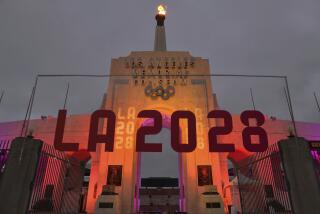‘84 Olympics Showed Off the Good Side of L.A. Area
- Share via
Doom and gloom had been widely forecast in the months before. But by the end of a remarkable 16-day run, the 1984 Summer Olympics had become established as one of Los Angeles’ finest hours of the 20th century.
Calamities from riots to earthquakes had struck the region before--and would rock it again. Outsiders joked about its traffic, smog and glitz. But for those two weeks, the Los Angeles megalopolis basked in glory.
When Los Angeles had successfully hosted the 1932 Olympics amid the Great Depression, the event had served as the city’s coming-out party.
In 1984, as the world watched on television, the Olympics “announced that Los Angeles had arrived as a great international city,” said Kevin Starr, a historian and the state librarian.
In truth, the Summer Games needed the assistance and athletic facilities of neighboring cities and counties to pull off the feat.
The city had been slow to embrace the Games, fearing either a financial debacle, as had befallen Montreal after the 1976 Olympics, or a terrorist incident, as had bloodied the Munich Games of 1972.
Mayor Tom Bradley and a few community leaders pushed aside civic indifference and won the International Olympic Committee’s approval to host the games. When the city balked at accepting financial responsibility, a private committee took the lead, eventually forming the Los Angeles Olympic Organizing Committee.
The massive effort worked in the end, but for a long time apprehension dominated media coverage: Would athletes be stranded in traffic gridlock? Would terrorists strike? Would crime and price gouging smear the city’s image?
Then, less than three months before the opening ceremonies, the Soviet Union announced its boycott of the Games, claiming security measures were inadequate to protect the safety of its athletes. The excuse was flimsy. It was more likely Cold War payback against the United States for having boycotted the 1980 Games in Moscow.
In June, the Olympic Arts Festival, featuring world-renowned and local artists, started getting people in the mood for the Games. And the worries that had beset the Los Angeles Games started to lift as the crowd-pleasing 9,300-mile torch relay reached Southern California.
On July 28, 1984, President Reagan officially opened the Games of the XXIII Olympiad before 92,655 at the Los Angeles Memorial Coliseum. When Rafer Johnson ran up 99 Coliseum steps and ceremoniously ignited the Olympic flame, the party was on.
A record 7 million tickets were sold for competitions in two dozen sports, from Ventura County to San Diego County. Residents and visitors alike seemed smitten with the Olympic spirit and thousands swapped souvenir pins.
Sure, there were glitches, such as ticket snafus. But for the most part, it was a sort of Murphy’s Law in reverse: Whatever could go right, did go right.
*
The days were sparkling, with little visible smog. The freeways flowed more freely than in a decade. Even what had been ominously labeled “Black Friday” (because of that day’s busy schedule) was free of traffic congestion.
The Games benefited from good fortune, but success evolved primarily from six years of meticulous planning. Hotel rooms were secured, the Bradley International Terminal was completed at LAX, truck companies agreed to stay off the freeways during the day. A logistical puzzle of a million pieces was tracked by technology now commonplace but then considered cutting-edge.
The athletic competition was spirited but suffered from the absence of some top Soviet bloc athletes. Gymnast Mary Lou Retton, sprinter Carl Lewis and boxer Paul Gonzales were among the headliners. Also participating were two athletes who would later become household names: Michael Jordan and Mark McGwire.
Far from finishing in the red, the Games produced a substantial surplus: $222.7 million. A final accounting later showed the surplus to be even larger--$232.5 million. Forty percent of that surplus was used to establish the Amateur Athletic Foundation of Los Angeles. To date, it has given $80 million to conduct youth sports activities and clinics and to upgrade athletic facilities.
The bottom line achievement came from a corporate-style strategy put together by Peter V. Ueberroth, president of the L.A. Olympic Organizing Committee, and his associates. They got top dollar for TV rights and scores of “exclusive” sponsorships, leading to endless jokes about the Games’ “official” this or that. And it brought severe criticism that the Games were being tarnished by the commercialization. But financially, the game plan succeeded, setting a model for staging future Olympics without bankrupting the host city.
When the Olympic flame was extinguished at the closing ceremonies, the 16-day party came to an end. But residents continue to cherish the memory of a Los Angeles that did things right.
More to Read
Go beyond the scoreboard
Get the latest on L.A.'s teams in the daily Sports Report newsletter.
You may occasionally receive promotional content from the Los Angeles Times.










